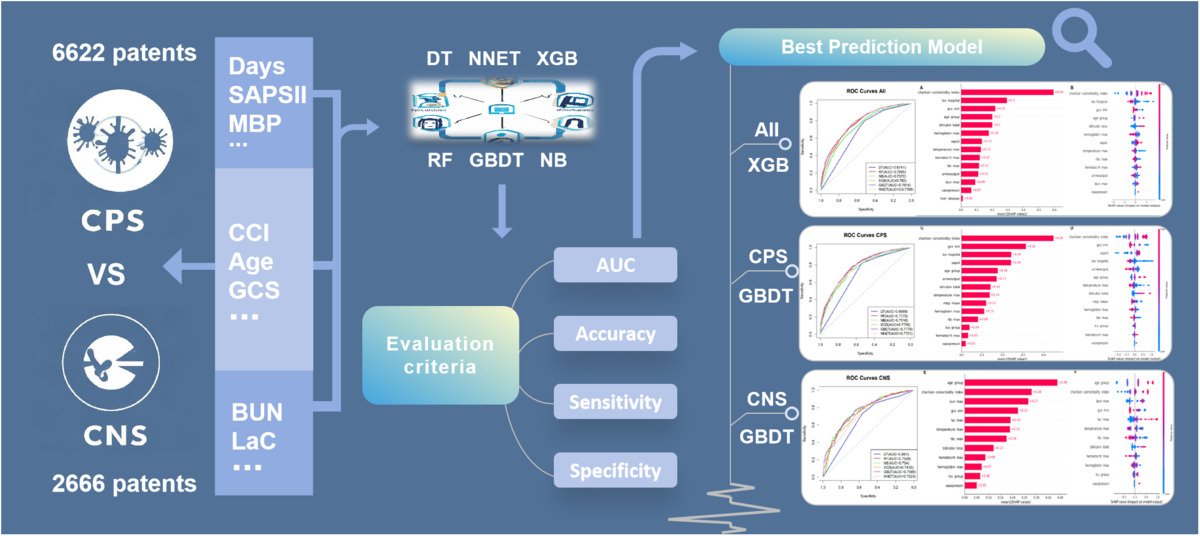Current issue
Archive
Manuscripts accepted
About the Journal
Editorial office
Editorial board
Section Editors
Abstracting and indexing
Subscription
Contact
Ethical standards and procedures
Most read articles
Instructions for authors
Article Processing Charge (APC)
Regulations of paying article processing charge (APC)
INFECTIOUS DISEASES / RESEARCH PAPER
Machine learning for the prediction of in-ICU mortality in sepsis: an observational study using the MIMIC IV database
1
Xi’an Jiaotong University, China
2
First Affiliate Hospital of Xi’an Jiaotong University, China
Submission date: 2024-07-10
Final revision date: 2024-11-27
Acceptance date: 2024-12-12
Online publication date: 2025-04-20
KEYWORDS
TOPICS
ABSTRACT
Introduction:
To identify the key risk factors influencing in-ICU mortality of patients with sepsis and develop prognosis prediction models for patients with culture-positive sepsis (CPS) and culture-negative sepsis (CNS) patients.
Material and methods:
Data were extracted from the MIMIC-IV database, which included 9288 patients with sepsis. The whole sample was divided into CPS (6622 patients) and CNS groups (2666 patients). We established six machine learning models, including DT, RF, NB, XGB, GBDT and NNET, to predict in-ICU death for all study samples, CPS and CNS subgroups, respectively. Model performance were assessed using AUC, accuracy, sensitivity, and specificity. SHAP values were used to explain the effect of variables on model results.
Results:
The in-ICU mortality rate was 54.58% for the whole study sample, the difference in in-ICU mortality between the CPS (55.19%) and CNS (53.04%) groups was not statistically significant. Main Significant influential factors identified included Charlson comorbidity index (CCI), number of days in hospital, Glasgow Coma Scale (GCS), older age, total bilirubin (TBil). The XGB model performed best in the overall sample (AUC = 0.782), while the GBDT model was most effective for the CPS group (AUC = 0.7813) and the CNS group (AUC = 0.7582).
Conclusions:
This study identified key risk factors for in-ICU death in patients with sepsis and highlights differences in clinical characteristics between patients with CPS and CNS. These findings may contribute to the development of personalized treatment strategies and risk assessment, thereby improving the prognosis of septic patients, especially patients with CNS.
To identify the key risk factors influencing in-ICU mortality of patients with sepsis and develop prognosis prediction models for patients with culture-positive sepsis (CPS) and culture-negative sepsis (CNS) patients.
Material and methods:
Data were extracted from the MIMIC-IV database, which included 9288 patients with sepsis. The whole sample was divided into CPS (6622 patients) and CNS groups (2666 patients). We established six machine learning models, including DT, RF, NB, XGB, GBDT and NNET, to predict in-ICU death for all study samples, CPS and CNS subgroups, respectively. Model performance were assessed using AUC, accuracy, sensitivity, and specificity. SHAP values were used to explain the effect of variables on model results.
Results:
The in-ICU mortality rate was 54.58% for the whole study sample, the difference in in-ICU mortality between the CPS (55.19%) and CNS (53.04%) groups was not statistically significant. Main Significant influential factors identified included Charlson comorbidity index (CCI), number of days in hospital, Glasgow Coma Scale (GCS), older age, total bilirubin (TBil). The XGB model performed best in the overall sample (AUC = 0.782), while the GBDT model was most effective for the CPS group (AUC = 0.7813) and the CNS group (AUC = 0.7582).
Conclusions:
This study identified key risk factors for in-ICU death in patients with sepsis and highlights differences in clinical characteristics between patients with CPS and CNS. These findings may contribute to the development of personalized treatment strategies and risk assessment, thereby improving the prognosis of septic patients, especially patients with CNS.
Share
RELATED ARTICLE
We process personal data collected when visiting the website. The function of obtaining information about users and their behavior is carried out by voluntarily entered information in forms and saving cookies in end devices. Data, including cookies, are used to provide services, improve the user experience and to analyze the traffic in accordance with the Privacy policy. Data are also collected and processed by Google Analytics tool (more).
You can change cookies settings in your browser. Restricted use of cookies in the browser configuration may affect some functionalities of the website.
You can change cookies settings in your browser. Restricted use of cookies in the browser configuration may affect some functionalities of the website.



